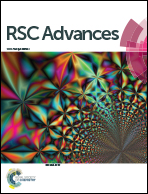In situ formed metal nanoparticle systems for catalytic reduction of nitroaromatic compounds†
Abstract
Developing robust and facile catalytic systems for converting nitroaromatic compounds to NH2-containing compounds are of importance to decrease or even eliminate their toxicity or risk in the environment. In view of in situ formed metal nanoparticles, the metal ion (Cu2+, Ag+, AuCl4−, Co2+ and Ni2+)/NaBH4 systems were employed to catalyze the reduction reaction of nitroaromatic compounds. By employing the reduction of 4-nitrophenol (4-NP) to 4-aminophenol (4-AP) as a model reaction, the effects of concentration of NaBH4, 4-NP and metal ions on the rate constants of the catalytic reduction reactions were systematically investigated. Apparent activation energies of these metal ion/NaBH4 catalytic systems were further measured and compared. In situ formed metal NPs could be characterized by X-ray diffraction (XRD) and transmission electron microscopy (TEM). Furthermore, these metal ion/NaBH4 systems were successfully employed to catalyze the reduction reaction of a series of other nitroaromatic compounds. These metal ion/NaBH4 catalytic systems investigated in this protocol are simple and do not require the preparation of metal nanoparticles in advance, compared with previous related reports.


 Please wait while we load your content...
Please wait while we load your content...